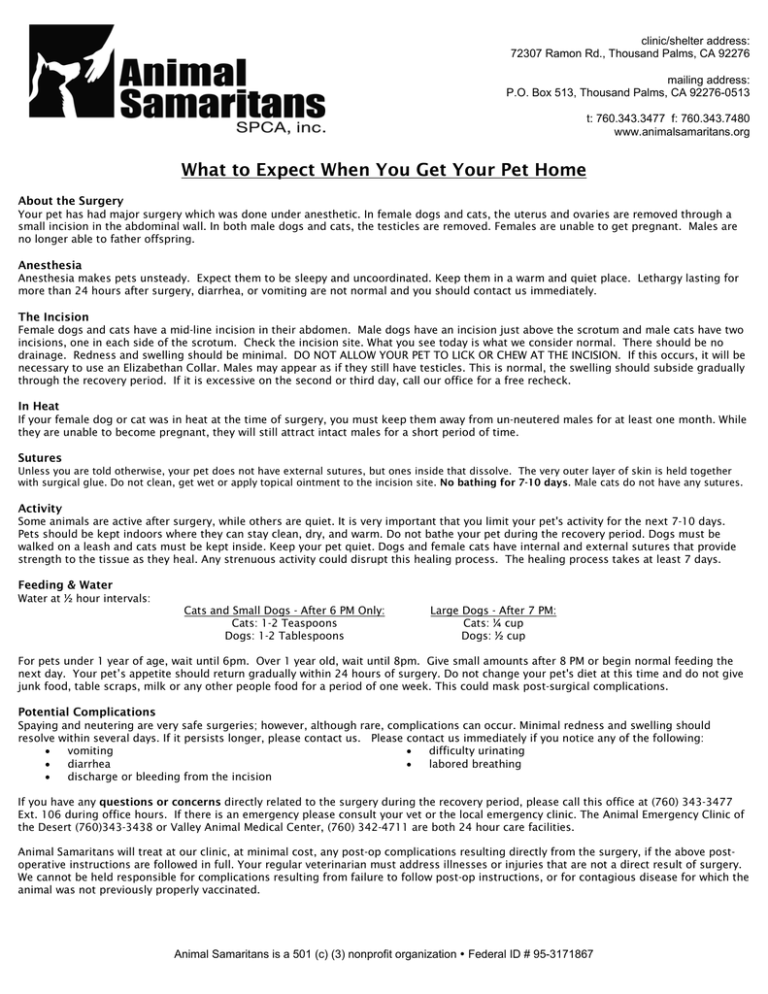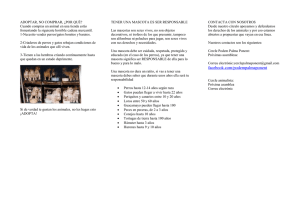What to Expect When You Get Your Pet Home
Anuncio

clinic/shelter address: 72307 Ramon Rd., Thousand Palms, CA 92276 mailing address: P.O. Box 513, Thousand Palms, CA 92276-0513 t: 760.343.3477 f: 760.343.7480 www.animalsamaritans.org What to Expect When You Get Your Pet Home About the Surgery Your pet has had major surgery which was done under anesthetic. In female dogs and cats, the uterus and ovaries are removed through a small incision in the abdominal wall. In both male dogs and cats, the testicles are removed. Females are unable to get pregnant. Males are no longer able to father offspring. Anesthesia Anesthesia makes pets unsteady. Expect them to be sleepy and uncoordinated. Keep them in a warm and quiet place. Lethargy lasting for more than 24 hours after surgery, diarrhea, or vomiting are not normal and you should contact us immediately. The Incision Female dogs and cats have a mid-line incision in their abdomen. Male dogs have an incision just above the scrotum and male cats have two incisions, one in each side of the scrotum. Check the incision site. What you see today is what we consider normal. There should be no drainage. Redness and swelling should be minimal. DO NOT ALLOW YOUR PET TO LICK OR CHEW AT THE INCISION. If this occurs, it will be necessary to use an Elizabethan Collar. Males may appear as if they still have testicles. This is normal, the swelling should subside gradually through the recovery period. If it is excessive on the second or third day, call our office for a free recheck. In Heat If your female dog or cat was in heat at the time of surgery, you must keep them away from un-neutered males for at least one month. While they are unable to become pregnant, they will still attract intact males for a short period of time. Sutures Unless you are told otherwise, your pet does not have external sutures, but ones inside that dissolve. The very outer layer of skin is held together with surgical glue. Do not clean, get wet or apply topical ointment to the incision site. No bathing for 7-10 days. Male cats do not have any sutures. Activity Some animals are active after surgery, while others are quiet. It is very important that you limit your pet's activity for the next 7-10 days. Pets should be kept indoors where they can stay clean, dry, and warm. Do not bathe your pet during the recovery period. Dogs must be walked on a leash and cats must be kept inside. Keep your pet quiet. Dogs and female cats have internal and external sutures that provide strength to the tissue as they heal. Any strenuous activity could disrupt this healing process. The healing process takes at least 7 days. Feeding & Water Water at ½ hour intervals: Cats and Small Dogs - After 6 PM Only: Cats: 1-2 Teaspoons Dogs: 1-2 Tablespoons Large Dogs - After 7 PM: Cats: ¼ cup Dogs: ½ cup For pets under 1 year of age, wait until 6pm. Over 1 year old, wait until 8pm. Give small amounts after 8 PM or begin normal feeding the next day. Your pet’s appetite should return gradually within 24 hours of surgery. Do not change your pet's diet at this time and do not give junk food, table scraps, milk or any other people food for a period of one week. This could mask post-surgical complications. Potential Complications Spaying and neutering are very safe surgeries; however, although rare, complications can occur. Minimal redness and swelling should resolve within several days. If it persists longer, please contact us. Please contact us immediately if you notice any of the following: • vomiting • difficulty urinating • diarrhea • labored breathing • discharge or bleeding from the incision If you have any questions or concerns directly related to the surgery during the recovery period, please call this office at (760) 343-3477 Ext. 106 during office hours. If there is an emergency please consult your vet or the local emergency clinic. The Animal Emergency Clinic of the Desert (760)343-3438 or Valley Animal Medical Center, (760) 342-4711 are both 24 hour care facilities. Animal Samaritans will treat at our clinic, at minimal cost, any post-op complications resulting directly from the surgery, if the above postoperative instructions are followed in full. Your regular veterinarian must address illnesses or injuries that are not a direct result of surgery. We cannot be held responsible for complications resulting from failure to follow post-op instructions, or for contagious disease for which the animal was not previously properly vaccinated. Animal Samaritans is a 501 (c) (3) nonprofit organization y Federal ID # 95-3171867 dirección de la clínica/refugio: 72307 Ramon Rd., Thousand Palms, CA 92276 dirección de correo: P.O. Box 513, Thousand Palms, CA 92276-0513 t: 760.343.3477 f: 760.343.7480 www.animalsamaritans.org Qué puede esperar cuando lleve a su mascota a casa Acerca de la cirugía Su mascota ha tenido una cirugía mayor, la cual se realizó bajo anestesia. En perras y gatas, el útero y los ovarios se extirpan mediante una incisión pequeña en la pared abdominal. Tanto en perros como en gatos, los testículos se extirpan. Las hembras no pueden quedar embarazadas. Los machos no pueden procrear. Anestesia La anestesia produce inestabilidad en las mascotas. Anticipe que estarán soñolientas y con falta de coordinación. Manténgalas en un lugar cálido y tranquilo. Letargo que dure más de 24 horas después de la cirugía, diarrea y vómitos no son normales y usted debe contactarnos inmediatamente. La herida Las perras y las gatas tienen una incisión en el centro del abdomen. Los perros tienen una incisión justo encima del escroto y los gatos tienen dos incisiones, una en cada lado del escroto. Revise el lugar de la herida. Lo que usted está viendo hoy es lo que consideramos normal. No debe haber drenaje. La piel roja e hinchazón deben ser mínimas. NO PERMITA QUE SU MASCOTA LAMA O MUERDA LA HERIDA. Si esto ocurre, será necesario usar un collar Isabelino. Los machos pueden parecer como si tuvieran testículos. Esto es normal, la hinchazón debe bajar gradualmente durante el período de recuperación. Si es excesiva al segundo o tercer día, llame a nuestra oficina para una re-revisión gratis. En celo Si su perra o gata estuvo en celo al momento de la cirugía, debe mantenerla alejada de los machos que no están castrados, por lo menos por un mes. A pesar de que no pueden quedar embarazadas, todavía atraerán a los machos intactos durante un corto período de tiempo. Suturas A menos que le digan lo contrario, su mascota no tiene suturas externas, sólo internas que se disolverán. La capa más externa de la piel está unida con un pegamento quirúrgico. No limpie, moje o aplique ungüento tópico al lugar de la herida. No bañe a la mascota durante 7 a 10 días. Los gatos no tienen ninguna sutura. Actividad Algunos animales están activos después de la cirugía, mientras que otros están tranquilos. Es muy importante que limite la actividad de su mascota por los próximos 7 a 10 días. Debe mantener a las mascotas bajo techo, donde puedan permanecer limpias, secas y cálidas. No bañe a su mascota durante el período de recuperación. Debe caminar a los perros con una correa para perros y los gatos deben mantenerse dentro. Mantenga a su mascota tranquila. Los perros y las gatas tienen suturas internas y externas que fortalecen el tejido mientras se sanan. Cualquier actividad fuerte podría interrumpir este proceso de curación. El proceso de curación toma por lo menos siete (7) días. Alimentación y agua Agua en intervalos de ½ hora: Gatos y perros pequeños – sólo después de las 6 p.m.: Gatos: 1-2 cucharaditas Perros: 1-2 cucharaditas Perros grandes – después de las 7 p.m.: Gatos: ¼ taza Perros: ½ taza Para las mascotas menores de un año, espere hasta las 6 p.m. Para las mayores de un año, espere hasta las 8 p.m. Déle pequeñas cantidades después de las 8 p.m., o comience la alimentación normal al día siguiente. El apetito de su mascota debe regresar gradualmente a las 24 horas de la cirugía. No cambie la dieta de la mascota en este momento, y no le dé comida chatarra, sobras de la mesa, leche o cualquier otra comida humana durante el período de una semana. Esto podría ocultar cualquier complicación post-quirúrgica. Complicaciones potenciales La esterilización y la castración son cirugías muy seguras, sin embargo, y aunque poco frecuente, las complicaciones pueden ocurrir. La escasa hinchazón y piel roja debe resolverse a los pocos días. Si persiste por más tiempo, por favor, contáctenos. Por favor, contáctenos inmediatamente si observa cualquiera de los siguientes: • • • vómito diarrea flujo o sangrado de la herida • • dificultad al orinar dificultad al respirar Si tiene preguntas o inquietudes relacionadas directamente con la cirugía durante el período de recuperación, por favor, llame a esta oficina al (760) 343-3477 ext. 106 durante el horario de oficina. Si hay una emergencia, por favor, consulte a su veterinario o clínica de emergencia local. Animal Emergency Clinic of the Desert (760) 343-3438 o Valley Animal Medical Center (790) 342-4711 son ambas instalaciones de atención abiertas las 24 horas. Animal Samaritans atenderá en nuestra clínica, a un costo mínimo, cualquier complicación post-operatoria que resulte directamente de la cirugía, siempre y cuando las instrucciones post-operatorias anteriormente indicadas se lleven a cabalidad. Su veterinario regular debe tratar las enfermedades o lesiones que no son un resultado directo de la cirugía. No podemos ser responsables de las complicaciones que resulten de la incapacidad para seguir instrucciones post-operatorias, ni de enfermedades contagiosas por las cuales el animal no fue adecuadamente vacunado previamente. Animal Samaritans es una 501 (c) (3) organización sin fines de lucro y Identificación federal # 95-3171867

